High Command: Castle of the Keys Campaign Expansion – Faction Card Review

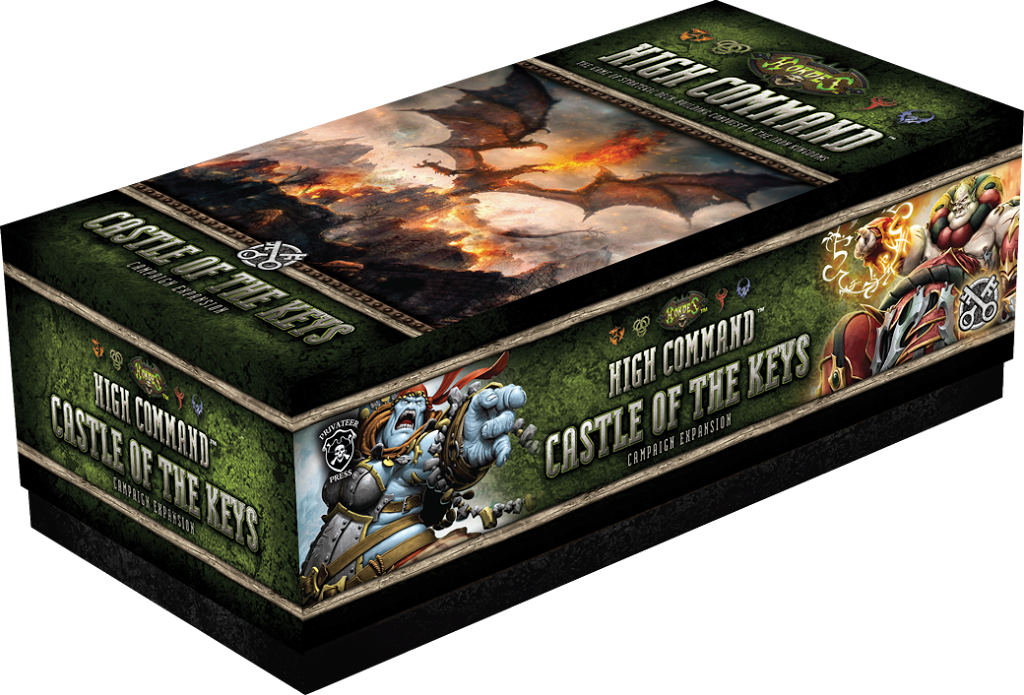 |
| Courtesy of Privateer Press Digital. Used with Permission. |
Castle of the Keys, the campaign expansion for Hordes: High Command is now in-the-wild with new Winds of War and Location decks and toys for every faction.
Castle of the Keys is relatively large release in terms of in-game impact. There is a lot to discuss, from the new faction cards, to the new Location and Winds of War decks. Last time I tried to cover so much in a single article, it went on forever, so our review of Castle of the Keys will be broken into two parts: the new faction cards and the Location and Winds of War decks.
In terms of the new faction cards, this is a 20%-lighter offering, as it only includes a warlock and three new detachment cards, but the impact of the new Location and Winds of War decks are quite large, which I feel more than covers any perceived deficit.
Trollbloods –
Calandra Truthsayer, Kriel Oracle, is the new Trollblood warlock in Castle of the Keys. Calandra probably does less in terms of board presence than any other warcaster or warlock card in the game. She has only 2 Power and her special ability does nothing for increasing damage or survivability. What she does bring is card draw in the form of her special ability, Good Omens, which allows you to draw two cards after you attack at Calandra’s location. While it is not the most impressive of abilities, I think she makes for a relatively solid warlock choice for a few reasons. First, she brings something new to her available detachments and to her faction in general, specifically card draw. The timing of Good Omens also stacks well with the faction’s many banking mechanics. Second, she makes for a good choice in the green detachment, since purple already has the supremely powerful Hoarluk Doomshaper, Rage of Dhunia.
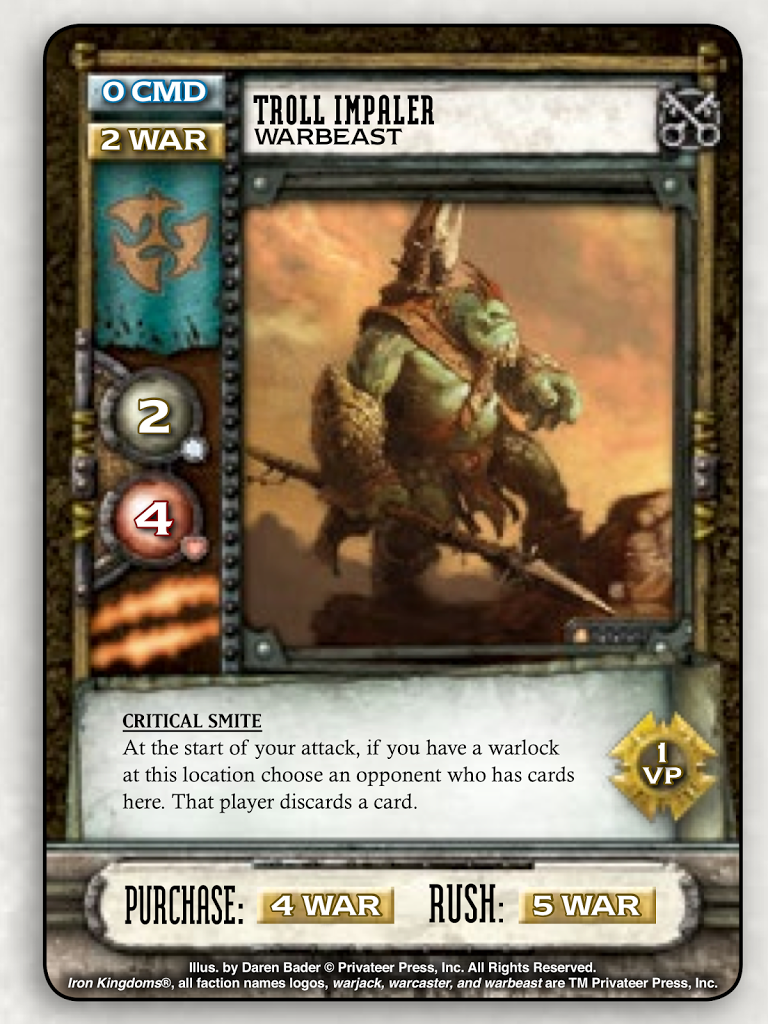 |
| Courtesy of Privateer Press Digital. Used with Permission. |
The Troll Impaler is a really strong addition to orange, yellow and green detachments. It has a gloriously low purchase and rush cost of 4 and 5 WAR respectively, it scores 1 VP, and has 2 WAR in purchase power. While Critical Smite and its stat block of 2 Power and 4 Health are not particularly impressive, the fact that you can rush it out for 5 WAR and it is worth 1 VP and 2 WAR makes it just a fantastic option if you are looking for cards that can increase tempo a bit.
The Kriels War Banner is purely a support card with its 0 Power and 3 Health. The Overcome ability combined with its 2 CMD to-purchase and 4 CMD to-rush pretty much make it a budget Fell Caller, forcing it to compete hard for space in orange and yellow detachments, but not red, where the Fell Caller is unavailable. If you can rush it to a location with the Sons of Brag, the combination of Call to Action and Overcome will allow you to rush cards to their location by 6 CMD/6 WAR to a minimum of their purchase cost, making even a Mountain King a viable rush option.
The Runebearer Elders is another card that plays into the Trollblood doctrine of banking lots and lots of cards. Its special ability, Power Glyphs, allows you to bank a card from the top of your army deck instead of from your hand. It has some great purchase power at 2 CMD, and its purchase cost of 4 CMD makes it quite affordable. Its lack of VP, however, will make fitting it into a deck a measured decision.
Circle Orboros –
Circle Orboros’s new warlock is Grayle the Farstrider. Grayle is a fantastic card for adjusting your location presence through his special ability, Darkest Night, which allows you to move friendly cards from Grayle’s location to other locations after the battle step. This makes for a means to overload a location with cards with risking losing too much deck advantage if you capture while also letting you effectively deny captures from opponents. Since Darkest Night triggers after the battle step, you can attack location A, then move one or two cards to location B where your opponent might have cards present. This means those cards do not get attacked at the second location and that your opponent will have no way to remove them before the start of their turn, thus denying a capture. I like this card quite a bit, especially against aggressive decks from Cryx, Legion, and Circle.
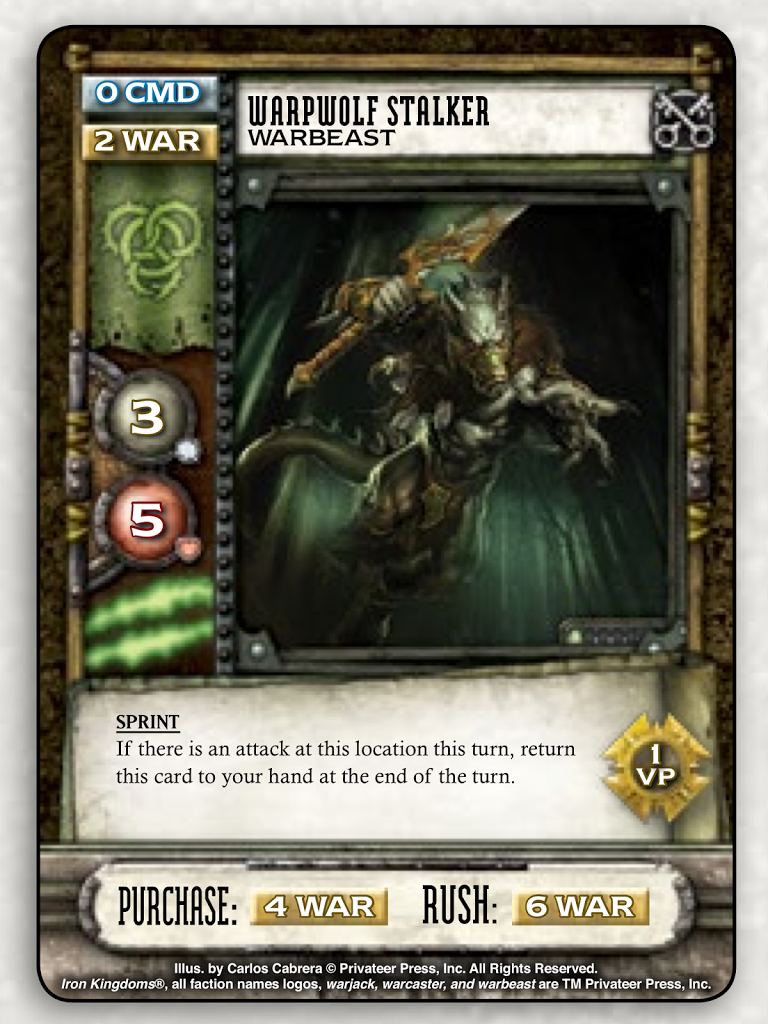 |
| Courtesy of Privateer Press Digital. Used with Permission. |
The Warpwolf Stalker is effectively a budget version of the Feral Warpwolf. It has the same combat stats of 3 Power and 5 Health, it is worth 1 VP and 2 WAR in resource, and it purchases and rushes for 4 and 6 WAR respectively. The Sprint rule forces the Stalker back to your hand if it survives at an attack a location. If you combine it with Grayle’s Darkest Night ability, you can have the Stalker attack at a location, then relocate to a different location where an attack did not happen, negating the requirement to return the card to your hand. Given its available detachments of green, blue, and purple, I am not sure how often the Stalker will show up in decks given that the Feral, which rushes for only 1 more WAR, has 2 VP, and has higher purchasing power, is also available in these detachments in equal numbers. If anything, I suspect that the Stalker will appear beside Feral Warpwolves instead of in lieu of them. That said, the Stalker is an amazing early-game rush for Circle since you can rush it turn three, return it to your hand the following turn, then use its 2 WAR in resource to rush another warbeast on turn four, which is quite powerful given Circle’s impressive rush margins.
Reeves of Orboros are an incredibly cheap warrior card at 2 CMD to-purchase and 3 to-rush. While their stats (1 Power, 2 Health) and resource (1 CMD, 1 WAR) are not terribly exciting, the Camouflage rule makes them into a cheap denial tool for stopping captures. This does make them compete some with Druids of Orboros who also have the Camouflage rule, but only when building with the Yellow detachment where both are available. Rush them to a key location when needed, then send them to occupying forces at the first opportunity.
The last new card for Circle Orboros in Castle of the Keys is the Reeve Master Huntsman. It has decent purchasing power at 2 CMD and fair stats at 3 Power and 3 Health. While its purchase and rush cost of 4 and 6 CMD make it a bit on the pricey side for its stats, the Reeve Commander rule grants +1 Power and Health to other friendly Reeves cards at its location, and it scores 1 VP as well, meaning that you will certainly want to include both in a deck if you plan on taking either. Fortunately, their distribution is identical to the normal Reeves card, so making this work should not be terribly difficult provided you are running at least two of the orange, yellow, and green detachments.
Skorne –
Skorne’s new warlock this expansion is Dominar Rasheth. While his 2 Power is not terribly thrilling, his ability, Plague Wind, causes enemy cards at his location to suffer -1 Health, making him a solid choice to send against locations swarmed with three or more enemy cards. He is available to run with either the red or yellow detachments, but I feel like he has a more unique presence in yellow, as the other available warlocks for yellow are both focused on keeping your cards alive, not making the enemy’s easier to kill.
The Basilisk Krea is the new warbeast for Skorne in Castle of the Keys. At first blush, the Krea is not the most exciting of cards. Its resource value is only 1 CMD/1 WAR, its stats are 1 Power and 3 Health, and its special ability, Paralytic Aura, which causes enemy cards at its location to lose Superior Range, is quite limited in application. However, it purchases and rushes for 3 WAR and 5 WAR respectively, and it is worth 1 VP, which is intriguing considering Skorne’s lack of cheap cards that score VPs. The Krea pairs well with Master Ascetic Naaresh, whose special ability makes it so that friendly warbeasts at his location cannot be destroyed, making the pairing an effective way to deny a capture for the opponent or enable one for the Skorne player.
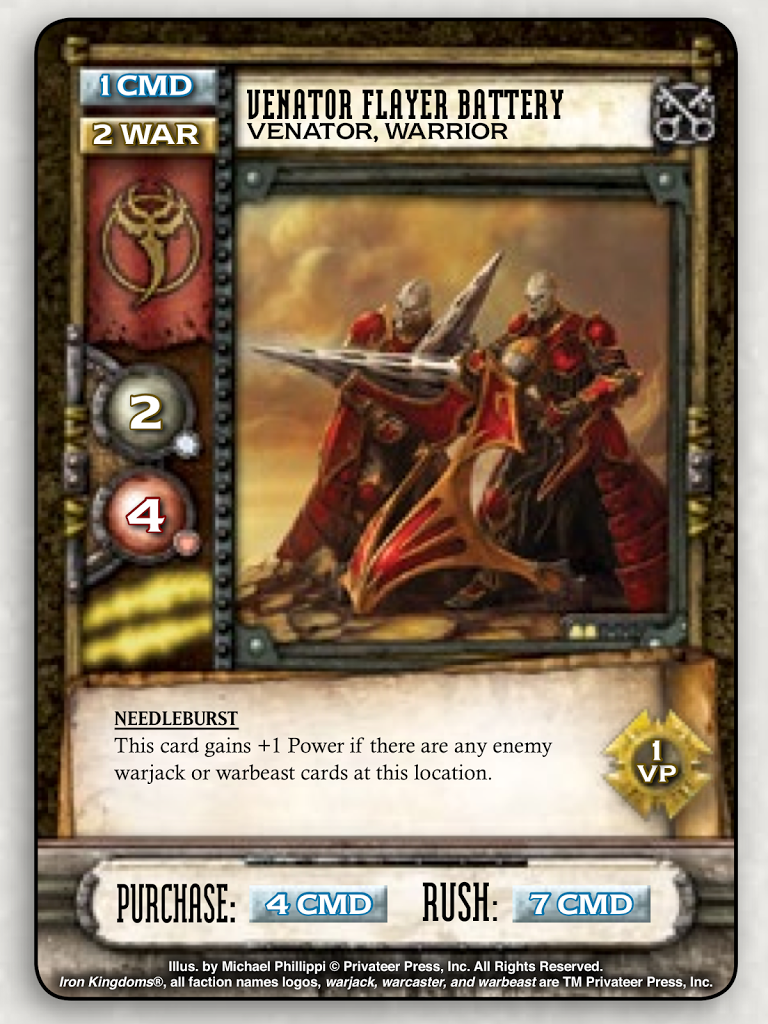 |
| Courtesy of Privateer Press Digital. Used with Permission |
The Venator Flayer Battery is a great addition to the yellow and blue detachments for its modest purchase cost, solid resource stats, and its 1 VP. With such a high rush margin, it is not the most efficient card to try to play directly from your reserves, but if you can get it on the field, its 2 Power and Needleburst ability give it some teeth.
The final card for Skorne in Castle of the Keys is the Praetorian Karax. While its lack of VP and 1 Power make it less-than-thrilling, it still has quite a bit of value and application. First, its 2 CMD in resource provides solid purchasing power. Second, its 4 Health and the Ranked Attacks ability, which denies enemies from destroying other cards at the Karax’s location, make it a strong way to apply ablative wounds to your other cards. Last, its purchase cost of 3 CMD makes it quite affordable. It pairs particularly well with the Siege Animantarax thanks to its Weapon Platform ability and its already high Health value.
Legion of Everblight –
Rhyas, Sigil of Everblight is a card specifically designed for games with three or more players involved thanks to her special ability, Tide of Blood, which doubles her base Power value of 3 if more than one opponent has cards at her location. There really is not much to say about her other than her value will be determined largely on the type of game you are playing. In two-player games, I would suggest taking another warlock to fill her slot, but in games of three-or-more, she seems like a fair choice for your blue or red detachments.
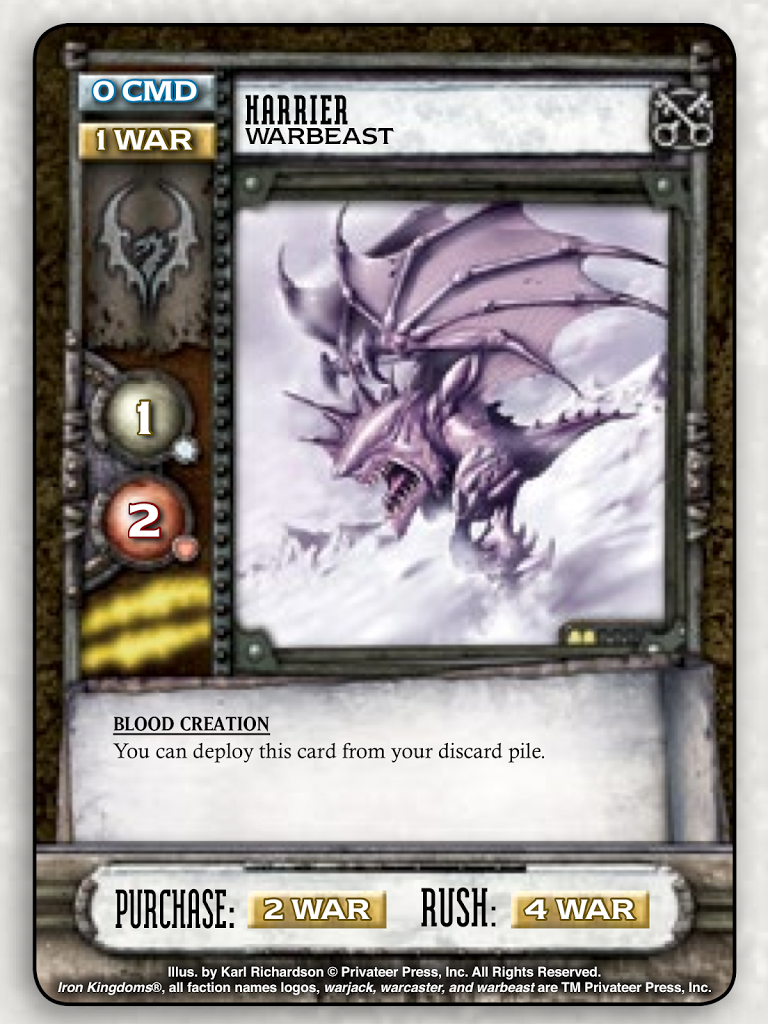 |
| Courtesy of Privateer Press Digital. Used with Permission |
The Harrier is a budget warbeast for Legion players that seems specifically designed to allow you to refresh your reserves while not effectively “losing” the card. Blood Creation, its special ability, allows you to deploy the Harrier from your discard pile, meaning that you can discard the Harrier to refresh a card in your reserves, then pay its normal purchase cost of 2 WAR to get it on the field. Alternatively, you can get around rushing restrictions from cards like Narrow Streets by paying the purchase cost of a Harrier to send it from reserves to discard, then pay its purchase cost again to deploy it.
The Dragonspawn Shepherds card is a really interesting addition to Legion decks. At 3 CMD to-purchase and 4 CMD to-rush, it is fairly affordable, and its resource stat of 1 CMD/2 WAR is pretty strong. While it does not score, the Beast Master ability allows you to effectively grant the Blight Gift rule to any warbeast, allowing you to pay either CMD, WAR, or a combination of the two in order to deploy or rush a warbeast to a location, making it a viable option for decks that are lacking in cards with Blight Gift specifically.
The Longbow Archer Champions are basically Longbow Archers on steroids. They have stronger purchasing power at 2 CMD, better stats at 3 Power and 2 Health, and they score a VP as well. Like the original Longbow Archer card, the Champions also have the Superior Range rule, which provides some protection. They pay for these buffs with increased purchase and rush cost, naturally, but that is to be expected. Try to pair this card with decks built around Strider Rangers and Lylyth, Shadow of Everblight.
Stay tuned for our upcoming reviews on the new Winds of War and Location decks within the next few weeks!





